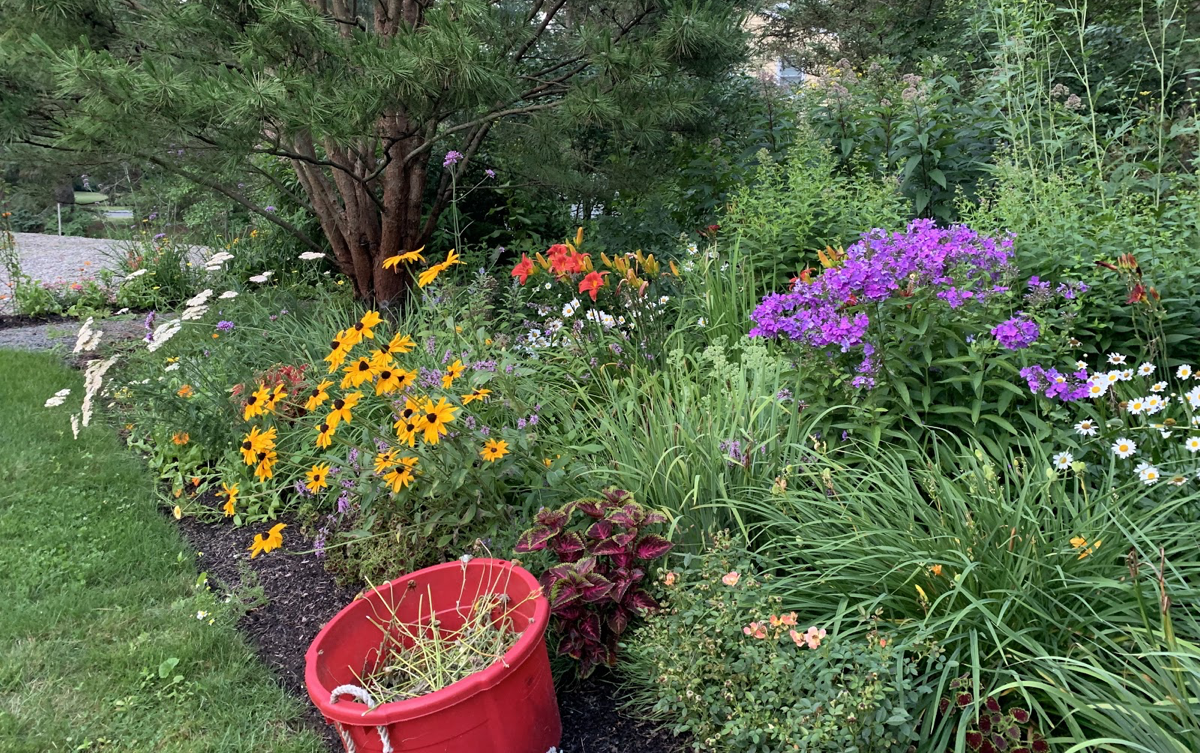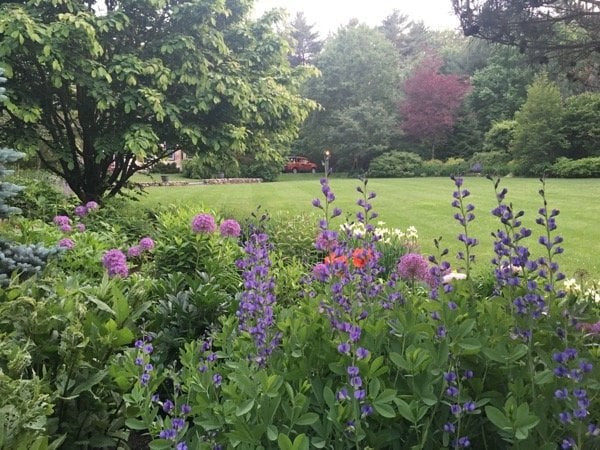In Part I about weeding your garden like a pro, we discussed mindset and approach. Now, it’s time to demystify all those weeds. What are they all about anyway? I mean, why do they even show up in the first place?
Let’s find out what the heck is going on with weeds.
Some say a weed is any plant you don't want. And on some level that’s true. If you have a specific design – a garden expression -- and an unplanned plant shows up, sure, you can call it a weed and pull it. But is it really a weed? Is a seedling from a maple tree or a Rose of Sharon a weed? Are the new little Black-eyed Susans or Verbena bonariensis blooming in the middle of the boxwood border really so bad?
These examples are of trees, shrubs, perennials and annuals that you likely already have in your garden, successfully procreating in your landscape. Remember, plants have one goal: live and reproduce. So, sure, these plants show up occasionally in areas where we don't want them. You have a simple choice to remove them or keep them, transplant them or pot them up and give them to friends. When you see how readily they self-seed, you may decide removing is best and even wonder if there’s a way to stop the seeding altogether. The point is, these plants are not technically weeds. They’re what we call “volunteers.” They happily volunteer to grow in your garden for free!
There’s another category of plant that’s been labeled “weed” primarily because they have the ability to proliferate in the landscape very quickly through one of two means: seeds or roots.
Annuals (plants that live their full life cycles in just one year) such as Crabgrass (Digitaria sp.) are labeled a “weed” because they will spread rapidly by producing hundreds of thousands of seeds in that one, short year of life. This ensures that crabgrass will live on -- and on and on and on -- for eternity through a legacy of new seeds germinating with ease almost anywhere and everywhere. It has little use in the managed landscape or in the culinary world, or even in herbal medicine circles. Crabgrass’s prolific nature and low usefulness gets it top billing in the world of weeds. There are many plants like this -- Purslane (Portulaca oleracea) and Carpetweed (Mollugo verticillata) are two common players in the show of annual weeds.
 Perennials (plants that live for many years; often going through a die-back season and then returning) such as Dandelion (Taraxacum officinale) are labeled “weed” for being persistent plants that love our open lawn spaces. Dandelions will not only grow into a big leafy mass with many bright yellow flowers, they will also spread tens of thousands of seeds around to ensure that there are plenty more to come. The sad thing about a plant like dandelion -- and this is true for many of our labeled perennial weeds -- is that it’s a powerful medicinal plant with a long history of healing throughout the world. It has been labeled by the landscape industry as being totally useless and without any redeeming value, and by the medical industry for being nothing more than an old wives’ remedy with no real medicinal merit.
Perennials (plants that live for many years; often going through a die-back season and then returning) such as Dandelion (Taraxacum officinale) are labeled “weed” for being persistent plants that love our open lawn spaces. Dandelions will not only grow into a big leafy mass with many bright yellow flowers, they will also spread tens of thousands of seeds around to ensure that there are plenty more to come. The sad thing about a plant like dandelion -- and this is true for many of our labeled perennial weeds -- is that it’s a powerful medicinal plant with a long history of healing throughout the world. It has been labeled by the landscape industry as being totally useless and without any redeeming value, and by the medical industry for being nothing more than an old wives’ remedy with no real medicinal merit.
Many other plants have suffered this same fate: Plantain (Plantago major) and Nettles (Urtica dioica) are good examples. Both possess significant, useful medicinal properties but have been saddled with heavy weed labels to keep them out of our gardens.
What can we make of all of this? Why DO plants show up where they’re not supposed to be?

Have you ever heard the phrase, “Nature abhors a vacuum”? It’s been attributed to the famous ancient Greek philosopher Aristotle who used it to express the concept that empty space must be filled with something. According to Aristotle, that emptiness or nothingness runs entirely counter to the laws of nature and physics.
Our venerable philosopher may not have known it at the time, but weeds are the perfect proof of his theory.
It explains why weeds keep popping up in places where they’re not wanted, such as an open, mulched area or that pristine expanse of artfully placed river stone. You may have determined there should be nothing there, but Mother Nature will have other ideas and start inserting plants to fill those voids. They could be maple or dogwood seedlings, black-eyed Susan sprouts, or the dreaded crabgrass. It doesn’t matter. If the space is empty, Mother Nature’s going to fill it. If plants can grow there, they will.
As gardeners, we like the idea of carefully selected plants placed in well-chosen spots in our landscape. That’s Design – the conscious application of thought and the decision to grow or not grow plants in this particular place or that. The interplay of plants and the spaces in between them creates a flow for our eyes to follow. Sometimes it is the lack of space and the cohesion of plants that creates the perfect ambiance we crave.
Some gardens are sparser with large open spaces, perhaps utilizing trees or shrubs as the main horticultural focal points. Others are very formal, with distinct lines and shapes that create a certain effect or rhythm on the landscape. And still others are more organic and fulsome, with very few spaces in between plants, such as the English Cottage garden. There are many expressions along this garden-design continuum.
As you might imagine, each of these garden styles at opposite ends of the spectrum has its own unique set of benefits and challenges when it comes to weeds. At one end, you have the sparsely planted landscape with lots of spaces between plantings -- we'll call this Man's Landscape. At the other end, you have the heavily planted garden with barely any space between plantings -- we'll call this Nature's Landscape.
Man's Landscape, because it has lots of space between the plants, readily invites weeds to fill the empty spaces. However, those weeds are very easy to see and remove. The trick will be to always look in and under the plants to ensure there are no "hiders" taking up residence where you can't see them.
Nature's Landscape, with the many plants touching one another, makes it difficult for weeds to germinate. But when weeds do take sprout – oh, and they will -- it takes a keen eye and some effort to surgically remove those weeds.
Therein lies the dilemma. The sparser, more visibly designed and managed garden actually encourages weeds to grow but makes it easier to remove them. The lusher, more natural-looking garden filled with plants actually discourages weeds from growing, but the tenacious ones that do are more difficult to remove.
The choice is as much about effort as it is about aesthetics. Neither garden is the “right” one. I have to say, though, that Nature’s landscape will ultimately be more sustainable with less weeding effort required. However, there is a price you will have to pay for that eventual sustainability. When first planted, Nature’s Landscape will look more like Man’s Landscape because it takes time for all those plants to grow and fill in. In the meantime, you’ll have to deal with – you guessed it – weeds.
When designing, implementing, and shaping a Nature's Landscape, weeding must be an integral part of the acclimation and establishment maintenance regimen. Missing this step can spell disaster if weeds are allowed to not only invade the spaces, but also crowd out the plants so carefully chosen to create this vibrant expression of sustainable Nature.







Leave a comment